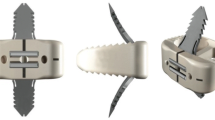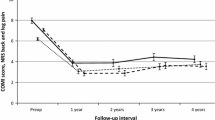Abstract
Patients with multisegmental degenerative disc disease (DDD) resistant to conservative therapy are typically treated with either fusion or non-fusion surgical techniques. The two techniques can be applied at adjacent levels using Dynesys® (Zimmer GmbH, Winterthur, Switzerland) implants in a segment-by-segment treatment of multiple level DDD. The objective of this study was to evaluate the clinical and radiological outcome of patients treated using this segment-by-segment application of Dynesys in some levels as a non-fusion device and in other segments in combination with a PLIF as a fusion device. A consecutive case series is reported. The sample included 16 females and 15 males with a mean age of 53.6 years (range 26.3–76.4 years). Mean follow-up time was 39 months (range 24–90 months). Preoperative Oswestry disability index (ODI), back- and leg-pain scores (VAS) were compared to postoperative status. Fusion success and system failure were assessed by an independent reviewer who analyzed AP and lateral X-rays. Back pain improved from 7.3 ± 1.7 to 3.4 ± 2.7 (p < 0.000002), leg pain from 6.0 ± 2.9 to 2.3 ± 2.9 (p < 0.00006), and ODI from 51.6 ± 13.2% to 28.7 ± 18.0% (p < 0.00001). Screw loosening occurred in one of a total of 222 implanted screws (0.45%). The results indicate that segment-by-segment treatment with Dynesys® in combination with interbody fusion is technically feasible, safe, and effective for the surgical treatment of multilevel DDD.




Similar content being viewed by others
References
Battié M, Videman T, Parent E (2004) Lumbar disk degeneration: epidemiology and genetic influences. Spine 29:2679–2690
Benoist M (2003) Natural history of the aging spine. Eur Spine J 12(Suppl 2):S86–S89
Bertagnoli R, Tropiano P, Zigler J, Karg A, Voigt S (2005) Hybrid constructs. Orthop Clin N Am 36:379–388
Boden SD, Davis DO, Dina TS, Patronas NJ, Wiesel SW (1990) Abnormal magnetic-resonance scans of the lumbar spine in asymptomatic subjects. A prospective investigation. J Bone Joint Surg 72:403–408
Bono CM, Lee CK (2004) Critical analysis of trends in fusion for degenerative disc disease over the past 20 years. Spine 29:455–463
Bono CM, Lee CK (2005) The influence of subdiagnosis on radiographic and clinical outcomes after lumbar fusion for degenerative disc disorders: an analysis of the literature from two decades. Spine 30:227–234
Boos N, Rieder R, Schade V, Spratt K, Semmer N, Aebi M (1995) Volvo award in clinical sciences. The diagnostic accuracy of magnetic resonance imaging, work perception and psychosocial factors in identifying symptomatic disk herniations. Spine 20:2613–2625
Brislin B, Vaccaro A (2002) Advances in posterior lumbar interbody fusion. Orthop Clin N Am 33:367–374
Carragee EJ, Paragioudakis StJ, Khurana S (2000) Lumbar high-intensity zone and discography in subjects without low back problems. Spine 25:2987–2992
Cheng BC, Gordon J, Cheng J, Welch WC (2007) Immediate biomechanical effects of lumbar posterior dynamic stabilization above a circumferential fusion. Spine 32(23):2551–2557
Diwan AD, Parvartaneni H, Cammisa F (2003) Failed degenerative lumbar spine surgery. Orthop Clin N Am 34:309–324
Fairbank JCT, Pynsent PB (2000) The Oswestry disability index. Spine 25:2940–2953
Freeman BJC, Licina P, Mehdian SH (2000) Posterior lumbar interbody fusion combined with instrumented postero-lateral fusion: 5-year results in 60 patients. Eur Spine J 9:42–46
Fritzell P, Hagg O, Wessberg P, Nordwall A, Swedish Lumbar Spine Group (2002) Chronic low back pain and fusion: a comparison of three surgical techniques: a prospective multicenter randomized study from the Swedish Lumbar Spine Study Group. Spine 27:1131–1141
Ghiselli G, Wang JC, Bhatia NN, Hsu WK, Dawson EG (2004) Adjacent segment degeneration in the lumbar spine. J Bone Joint Surg Am 86-A(7):1497–1503
Gillet P (2003) The fate of the adjacent motion segments after lumbar fusion. J Spinal Disord Tech 16(4):338–345
Glassman S, Gornet MF, Branch C, Polly D, Peloza J (2006) MOS short form 36 and Oswestry disability index outcomes in lumbar fusion: a multicenter experience. Spine J 6:21–26
Greiner-Perth R, Boehm H, Allam Y, Elsaghir H, Franke J (2004) Reoperation rate after instrumented posterior lumbar interbody fusion. Spine 29:2516–2520
Grob D, Benini A, Junge A, Mannion AF (2005) Clinical experience with the Dynesys semirigid fixation system for the lumbar spine: surgical and patient-oriented outcome in 50 cases after an average of 2 years. Spine 30(3):324–331
Guiot BH, Fessler RG (2000) Molecular biology of degenerative disc disease. Neurosurgery 47:1034–1040
Haig AJ (2002) Paraspinal denervation and the spinal degenerative cascade. Spine J 2:372–380
Hioki A, Miyamoto K, Kodama H, Hosoe H, Nishimoto H (2005) Two-level posterior lumbar interbody fusion for degenerative disc disease: improved clinical outcome with restoration of lumbar lordosis. Spine J 5:600–607
Jarvik J, Hollingworth W, Haegerty P, Haynor DR, Deyo RA (2001) The longitudinal assessment of imaging and disability of the back (LAIDBack) study: baseline data. Spine 26:1158–1166
Jayakumar P, Nnadi C, Saifuddin A, MacSweeney E, Casey A (2006) Dynamic degenerative lumbar spondylolisthesis: diagnosis with axial loaded magnetic resonance imaging. Spine 31:E298–E301
Junghanns H (1968) Die gesunde und die kranke Wirbelsäule in Röntgenbild und Klinik. Thieme, Stuttgart
Kang CH, Shin MJ, Kim SM, Lee SH, Lee CS (2007) MRI of paraspinal muscles in lumbar degenerative kyphosis patients and control patients with chronic low back pain. Clin Radiol 62:479–486
Keller TS, Harrison DE, Colloca CJ, Harrison DD, Janik TJ (2003) Prediction of osteoporotic spinal deformity. Spine 28:455–462
Kim KT, Lee SH, Lee YH, Bae SC, Suk KS (2006) Clinical outcomes of 3 fusion methods through the posterior approach in the lumbar spine. Spine 31:1351–1357
Kirkaldy-Willis WH, Farfan HF (1982) Instability of the lumbar spine. Clin Orthop 165:110–123
Kjaer P, Ch Leboeuf-Yde, Korsholm L, Sorensen JS, Bendix T (2005) Magnetic resonance imaging and low back pain in adults: a diagnostic imaging study of 40-year-old men and women. Spine 30:1173–1180
Lee C, Dorcil J, Radomisli TE (2004) Nonunion of the spine: a review. Clin Orthop 419:71–75
Madan SS, Boeree NR (2003) Comparison of instrumented anterior interbody fusion with instrumented circumferential lumbar fusion. Eur Spine J 2:567–575
Maghout-Jurati S, Franklin GM, Mirza SK, Wickizer TM, Fulton-Kehoe D (2006) Lumbar fusion outcomes in Washington State workers’ compensation. Spine 31:2715–2723
Masui T, Yukawa Y, Nakamura S, Kajino G, Matsubara Y, Kshiguro N (2005) Natural history of patients with lumbar disc herniation observed by magnetic resonance imaging for minimum 7 years. J Spinal Disord Tech 18:121–126
Niosi CA, Zhu QA, Wilson DC, Keynan O, Wilson DR, Oxland TR (2006) Biomechanical characterization of the three-dimensional kinematic behaviour of the Dynesys dynamic stabilization system: an in vitro study. Eur Spine J 15(6):913–922
Ohlin A, Karlsson M, Düppe H, Hasserius R, Redlund-Johnell I (1994) Complications after transpedicular stabilization of the spine. A survivorship analysis of 163 cases. Spine 19(24):2774–2779
Pappou IP, Cammisa FP, Girardi FP (2007) Correlation of end plate shape on MRI and disc degeneration in surgically treated patients with degenerative disc disease and herniated nucleus pulposus. Spine J 7:32–38
Pfirrmann CW, Metzdorf A, Zanetti M, Hodler J, Boos N (2001) Magnetic resonance classification of lumbar intervertebral disc degeneration. Spine 26(17):1873–1878
Podichetty VK (2007) The aging spine: the role of inflammatory mediators in intervertebral disc degeneration. Cell Mol Biol 53:4–18
Putzier M, Schneider SV, Funk JF, Tohtz SW, Perka C (2005) The surgical treatment of the lumbar disc prolapse: nucleotomy with additional transpedicular dynamic stabilization versus nucleotomy alone. Spine 30(5):E109–E114
Schaeren S, Broger I, Jeanneret B (2008) Minimum four-year follow-up of spinal stenosis with degenerative spondylolisthesis treated with decompression and dynamic stabilization. Spine 33(18):E636–E642
Schmoelz W, Huber JF, Nydegger T, Claes L, Wilke HJ (2003) Dynamic stabilization of the lumbar spine and its effects on adjacent segments: an in vitro experiment. J Spinal Disord Tech 16(4):418–423
Schnake KJ, Schaeren S, Jeanneret B (2006) Dynamic stabilization in addition to decompression for lumbar spinal stenosis with degenerative spondylolisthesis. Spine 31(4):442–449
Schwarzenbach O, Berlemann U, Stoll TM, Dubois G (2005) Posterior dynamic stabilization systems: Dynesys. Orthop Clin N Am 36:363–372
Solovieva S, Lohiniva J, Leino-Arjas P, Raininko R, Luoma K, Ala-Kokko L, Riihimaki H (2006) Intervertebral disc degeneration in relation to the COL9A3 and the IL-1β gene polymorphisms. Eur Spine J 15:613–619
Stoll TM, Dubois G, Schwarzenbach O (2002) The dynamic neutralization system for the spine: a multi-center study of a novel non-fusion system. Eur Spine J 11(Suppl 2):S170–S178
Suk S, Lee CK, Kim WJ, Lee JH, Cho KJ (1997) Adding posterior lumbar interbody fusion to pedicle screw fixation and posterolateral fusion after decompression in spondylolytic spondylolisthesis. Spine 22:210–219
Symmons DP, van Hemert AM, Vandenbroucke JP, Valkenburg HA (1991) A longitudinal study of back pain and radiological changes in the lumbar spines of middle aged women. II. Radiological findings. Ann Rheum Dis 50:162–166
Videman T, Battie MC, Ripatti S, Gill K, Manninen H, Kaprio J (2006) Determinants of the progression in lumbar degeneration: a 5-year follow-up of adult male monozygotic twins. Spine 31(6):671–678
Vishteh AG, Crawford NR, Chamberlain RH, Thramann JJ, Park SC (2005) Biomechanical comparison of anterior versus posterior lumbar threaded interbody fusion cages. Spine 30:302–310
Welch WC, Cheng BC, Awad TE, Davis R, Maxwell JH, Delamarter R, Wingate JK, Sherman J, Macenski MM (2007) Clinical outcomes of the Dynesys dynamic neutralization system: 1-year preliminary results. Neurosurg Focus 22(1):E8
White AA, Panjabi MM (1978) The basic kinematics of the human spine: a review of past and current knowledge. Spine 3:12–20
Wimmer C, Gluch H, Krismer M, Ogon M, Jesenko R (1997) AP-translation in the proximal disc adjacent to lumbar spine fusion. A retrospective comparison of mono- and polysegmental fusion in 120 patients. Acta Orthop Scand 68(3):269–272
Zanoli G, Strömqvist B, Jönsson B (2001) Visual analog scales for interpretation of back and leg pain intensity in patients operated for degenerative lumbar spine disorders. Spine 26:2375–2380
Conflict of interest statement
O. Schwarzenbach is consultant to Zimmer GmbH and has received project support.
Author information
Authors and Affiliations
Corresponding author
Rights and permissions
About this article
Cite this article
Schwarzenbach, O., Rohrbach, N. & Berlemann, U. Segment-by-segment stabilization for degenerative disc disease: a hybrid technique. Eur Spine J 19, 1010–1020 (2010). https://doi.org/10.1007/s00586-010-1282-4
Received:
Revised:
Accepted:
Published:
Issue Date:
DOI: https://doi.org/10.1007/s00586-010-1282-4




